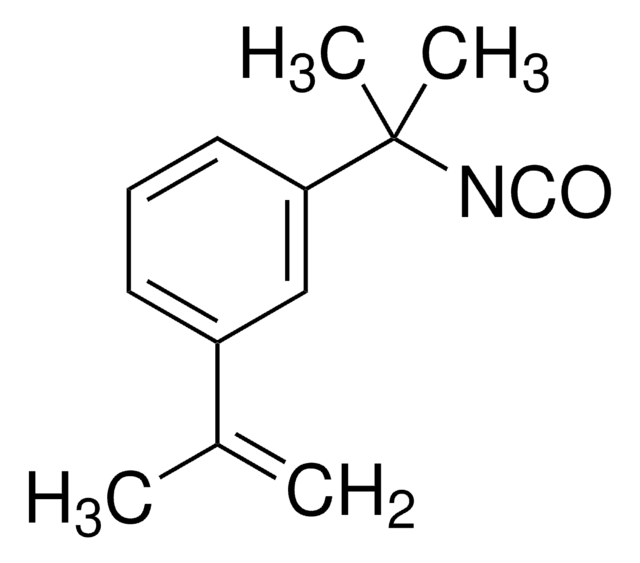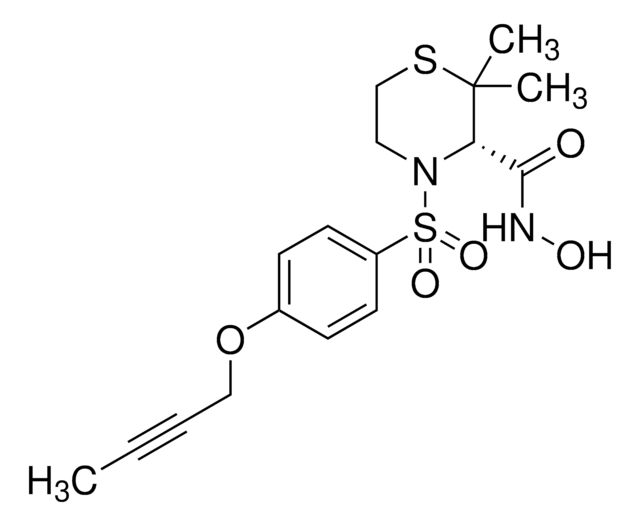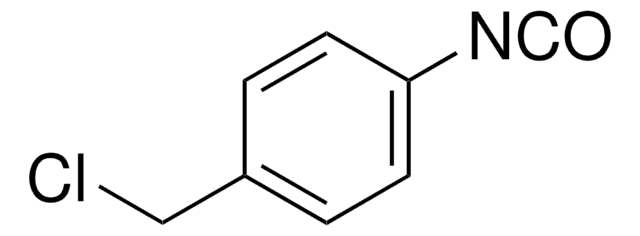Products may be shipped at a different temperature than the recommended long-term storage temperature. If the product quality is sensitive to short-term exposure to conditions other than the recommended long-term storage, it will be shipped on wet or dry-ice. If the product quality is NOT affected by short-term exposure to conditions other than the recommended long-term storage, it will be shipped at ambient temperature. As shipping routes are configured for minimum transit times, shipping at ambient temperature helps control shipping costs for our customers. For more information, please refer to the Storage and Transport Conditions document: https://www.sigmaaldrich.com/deepweb/assets/sigmaaldrich/marketing/global/documents/316/622/storage-transport-conditions-mk.pdf
477060
2-Isocyanatoethyl methacrylate
contains ≤0.1% BHT as inhibitor, 98%
Sinonimo/i:
2-(Methacryloyloxy)ethyl isocyanate, IEM
Scegli un formato
Scegli un formato
About This Item
Prodotti consigliati
Livello qualitativo
Saggio
98%
contiene
≤0.1% BHT as inhibitor
Indice di rifrazione
n20/D 1.45 (lit.)
P. ebollizione
211 °C (lit.)
Punto di fusione
−45 °C (lit.)
Densità
1.098 g/mL at 25 °C (lit.)
Temperatura di conservazione
2-8°C
Stringa SMILE
CC(=C)C(=O)OCCN=C=O
InChI
1S/C7H9NO3/c1-6(2)7(10)11-4-3-8-5-9/h1,3-4H2,2H3
RBQRWNWVPQDTJJ-UHFFFAOYSA-N
Cerchi prodotti simili? Visita Guida al confronto tra prodotti
Categorie correlate
Descrizione generale
Applicazioni
- A reactive monomer in the synthesis of poly(methyl urethane) acrylate oligomer for UV-curable coatings. By incorporating urethane and acrylate groups into the polymer, it enables the polymer to be utilized in UV-curable coatings, inks, and adhesives.
- An additive in propylene carbonate-based electrolyte to enhance its properties, such as viscosity, conductivity, and stability. This improves the overall performance of the electrolyte and the battery.
- As a modifier in the copolymerization process to prepare a bioprosthetic heart valve, which is used in the application of transcatheter aortic valve replacement.
- A latent cross-linker for adhesive resins and coatings.
Avvertenze
Danger
Indicazioni di pericolo
Classi di pericolo
Acute Tox. 1 Inhalation - Acute Tox. 4 Oral - Eye Dam. 1 - Resp. Sens. 1 - Skin Irrit. 2 - Skin Sens. 1
Codice della classe di stoccaggio
6.1A - Combustible acute toxic Cat. 1 and 2 / very toxic hazardous materials
Classe di pericolosità dell'acqua (WGK)
WGK 3
Punto d’infiammabilità (°F)
210.2 °F - closed cup
Punto d’infiammabilità (°C)
99 °C - closed cup
Scegli una delle versioni più recenti:
Possiedi già questo prodotto?
I documenti relativi ai prodotti acquistati recentemente sono disponibili nell’Archivio dei documenti.
I clienti hanno visto anche
-
How is shipping temperature determined? And how is it related to the product storage temperature?
1 risposta-
Utile?
-
-
How can I determine the shelf life / expiration / retest date of this product?
1 risposta-
If this product has an expiration or retest date, it will be shown on the Certificate of Analysis (COA, CofA). If there is no retest or expiration date listed on the product's COA, we do not have suitable stability data to determine a shelf life. For these products, the only date on the COA will be the release date; a retest, expiration, or use-by-date will not be displayed.
For all products, we recommend handling per defined conditions as printed in our product literature and website product descriptions. We recommend that products should be routinely inspected by customers to ensure they perform as expected.
For products without retest or expiration dates, our standard warranty of 1 year from the date of shipment is applicable.
For more information, please refer to the Product Dating Information document: https://www.sigmaaldrich.com/deepweb/assets/sigmaaldrich/marketing/global/documents/449/386/product-dating-information-mk.pdfUtile?
-
Filtri attivi
Il team dei nostri ricercatori vanta grande esperienza in tutte le aree della ricerca quali Life Science, scienza dei materiali, sintesi chimica, cromatografia, discipline analitiche, ecc..
Contatta l'Assistenza Tecnica.













